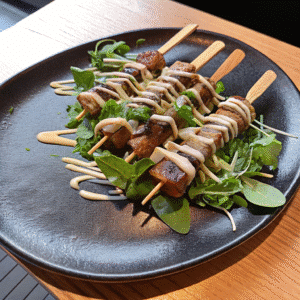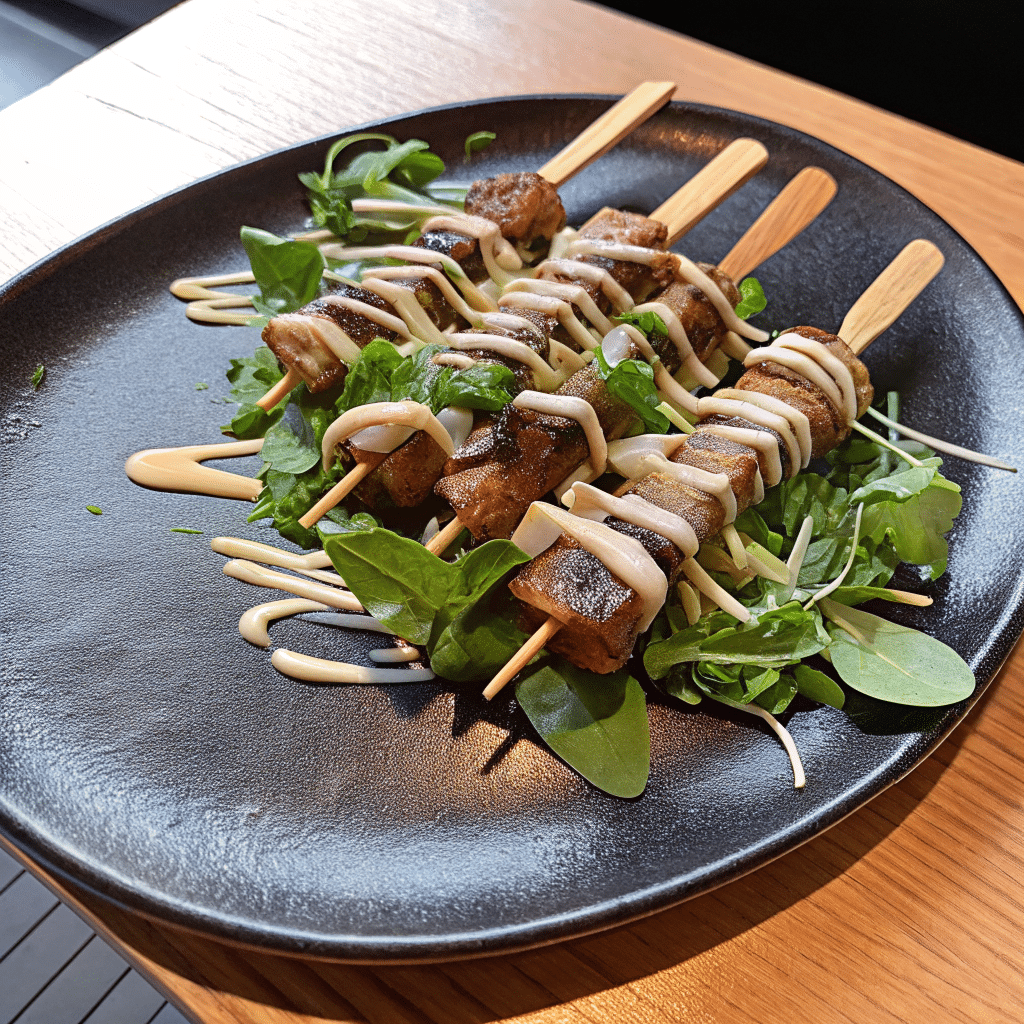In this article, I’ll walk you through everything you need to know about the speducci recipe—from ingredients and regional origins to step‑by‑step cooking instructions for speducci skewers recipe. You’ll learn how simple lamb cubes become irresistible grilled skewers, why so many folks swap between “spiedini” and speducci, and where to find the best cuts of lamb leg or shoulder. I’ll also answer the top questions: What is Speducci made of? What’s the difference between spiedini and speducci? What part of lamb is used? Get ready for delicious, easy‑to‑follow cooking guidance that brings Italy’s Abruzzo street‑food tradition into your kitchen.

Italian Lamb Speducci Skewers
Ingredients
- 1.5 lbs lamb shoulder or leg, cubed
- 2 tablespoons olive oil
- 2 garlic cloves, minced
- 1 tablespoon fresh rosemary, chopped
- 1 teaspoon sea salt
- 1/2 teaspoon black pepper
- 1 tablespoon lemon juice
- Wooden skewers, soaked
Instructions
- Combine lamb cubes with olive oil, garlic, rosemary, salt, pepper, and lemon juice in a bowl.
- Toss well to coat, cover, and refrigerate for at least 2 hours.
- Soak wooden skewers in water for 30 minutes.
- Thread 4–5 cubes of lamb onto each skewer.
- Preheat charcoal grill to medium-high heat.
- Grill skewers for 8–10 minutes, turning frequently for even char.
- Serve hot with crusty bread and lemon wedges.
Notes
Origins & Basics of the Speducci Recipe
What is Speducci made of? – The foundation of the dish
Speducci is traditionally made from small cubes of lamb (or sheep/mutton), typically from cuts like leg, shoulder, loin, or neck—with some fat included for juiciness. The lamb is cut into bite‑sized pieces, marinated simply with salt, olive oil, garlic, lemon juice, and herbs like rosemary or oregano. These meat pieces are threaded onto wooden or metal skewers—often soaked first—then grilled over charcoal for smoky flavor and a slightly crisp exterior. This is the heart of any speducci skewers recipe, offering succulent flavor with minimal fuss.
By contrast, many mainstream versions (sometimes labelled “spiedini”) may use chicken, beef, or even vegetables—but true speducci skewers recipe sticks with lamb or mutton for authenticity.
Difference between spiedini and speducci – regional names explained
Many people wonder if “spiedini” and “speducci” are different dishes. In reality, they refer to the same style of skewer, just from different Italian regions. Arrosticini—also called spiducci or spiedini in Abruzzo—are lamb skewers cooked over coals. Some writers use “spiedini” generally for meat on a stick, while “speducci” highlights the Abruzzo tradition specifically. In short: no real culinary difference—just local naming.
Making the Speducci Skewers Recipe at Home
Speducci skewers recipe: Easy steps to grill like a pro
When you’re ready to try a traditional speducci skewers recipe at home, all you need are a few basic ingredients and a hot grill. Start with 1–2 lbs of lamb (shoulder or leg works great), cut into small, uniform cubes. Mix them in a bowl with extra virgin olive oil, crushed garlic, chopped rosemary, salt, pepper, and a splash of lemon juice. Let the lamb marinate for at least 2 hours—or overnight for deeper flavor.
Next, soak your wooden skewers in water for 30 minutes to prevent burning. Then thread about 4–5 cubes of meat per stick, spacing them just slightly so the heat can circulate evenly. Grill over medium-high charcoal or gas for 8–10 minutes total, turning frequently until you see a crisp exterior and juicy center. This method captures the essence of Italian outdoor cooking.
Marinating techniques and tips for tender speducci
Marinating lamb for a speducci recipe is simple but important. A good marinade tenderizes the meat and enhances its flavor profile. Keep it rustic: use garlic, lemon zest, rosemary, and olive oil as your base. Avoid heavy sauces—this dish shines when it’s clean and herb-driven.
Consistency is key: cut your lamb cubes to the same size to ensure even grilling. These tweaks help elevate your speducci skewers recipe from good to unforgettable.
Choosing the Right Cut of Lamb for Speducci
What part of lamb is speducci?
If you’re wondering what part of lamb is best for a speducci recipe, the answer is simple: shoulder, leg, or sometimes loin. Traditional speducci, also known as arrosticini, is made from lean cuts with a small amount of fat to enhance flavor and moisture during grilling. Lamb shoulder is especially popular—it’s tender and rich with a bit of connective tissue that breaks down beautifully on the grill.
Some purists even mix lean and fatty cuts to recreate the texture found in the classic skewers from Abruzzo. Avoid overly fatty sections like breast or shank, which can flare up or become chewy. When prepping at home, ask your butcher for lamb shoulder or leg roast and request it cut into small cubes about ¾‑inch wide.
How to cut and prep lamb for speducci skewers
Prepping lamb for a speducci skewers recipe doesn’t require fancy tools, just a sharp knife and a bit of patience. Trim off any excess silver skin and large fat caps, then slice the meat into uniform cubes. The size matters—too large and it won’t cook evenly, too small and it dries out fast.
Once cut, toss the lamb cubes in your marinade of choice (see Part 2) and let it rest in the fridge, covered, for a few hours. If you’re using metal skewers, you can start threading immediately. For wood, always soak them in water for 30 minutes to prevent scorching.
Serving, Storing & Modern Twists on Speducci Skewers
Serving suggestions for speducci recipe
Speducci is best served hot off the grill—charred outside, juicy inside. Traditionally, it’s enjoyed with crusty Italian bread, a drizzle of olive oil, and maybe a splash of lemon. For a true Abruzzo-style experience, serve your speducci recipe alongside grilled vegetables, olives, and a glass of dry red wine like Montepulciano d’Abruzzo.
These skewers are meant to be eaten straight from the stick, no forks or knives needed. That casual feel makes them perfect for backyard gatherings or summer grill nights.
For sauces, keep it simple—try chimichurri, lemon-herb vinaigrette, or even tzatziki for a Mediterranean touch. But purists argue that a perfectly grilled speducci doesn’t need sauce at all.
Reheating tips and modern variations
If you’ve got leftovers, speducci stores well. Wrap them tightly and refrigerate for up to 3 days. To reheat, place skewers in a preheated 350°F oven for 10 minutes, or briefly warm on a skillet or grill. Avoid microwaving—lamb dries out quickly under intense heat.
For modern spins on the speducci skewers recipe, experiment with seasoning blends: Moroccan ras el hanout, Greek oregano blends, or even a smoky paprika rub can add unique flavor. You can also thread cherry tomatoes or bell pepper chunks between the lamb cubes for color and sweetness.
FAQs
What is Speducci made of?
Speducci is made of small cubes of lamb, usually from the leg, shoulder, or loin. The meat is marinated simply in olive oil, garlic, rosemary, lemon juice, and salt, then grilled on skewers over charcoal. It’s a traditional dish from Abruzzo, Italy, and known for its savory, smoky flavor.
What’s the difference between spiedini and speducci?
Speducci and spiedini both mean skewered meat, but the terms vary regionally. “Speducci” (or “arrosticini”) refers specifically to lamb skewers from Abruzzo, while “spiedini” is a broader term used across Italy for any type of meat skewer, including chicken, beef, or even breaded versions.
What is spiedini made of?
Spiedini can be made from lamb, beef, pork, chicken, or even seafood. The ingredients depend on the region and tradition. Some versions are layered with breadcrumbs, herbs, and cheese, then baked or grilled. Unlike speducci, which sticks with lamb, spiedini is more flexible in protein choice.
What part of lamb is speducci?
The best cuts of lamb for speducci are the shoulder, leg, or loin. These cuts offer the ideal balance of tenderness and fat content. Traditional speducci uses lean cubes interspersed with small bits of fat to help keep the skewers juicy when grilled over open flame.
Conclusion
Cooking speducci at home brings a taste of Italy’s Abruzzo region to your backyard. With a handful of ingredients and a hot grill, you can master this rustic lamb dish in no time. Whether you’re sharing skewers at a summer cookout or recreating a family favorite, this speducci recipe delivers bold flavor and timeless charm.
Hungry for more? Explore our Facebook Page for Italian recipes for your next mealtime masterpiece. Happy cooking!


